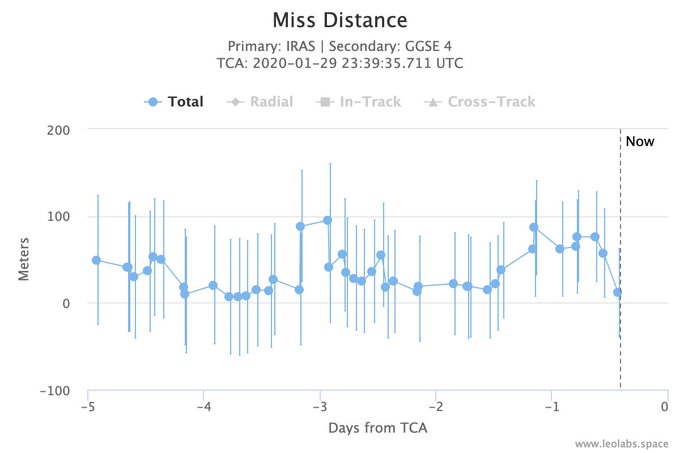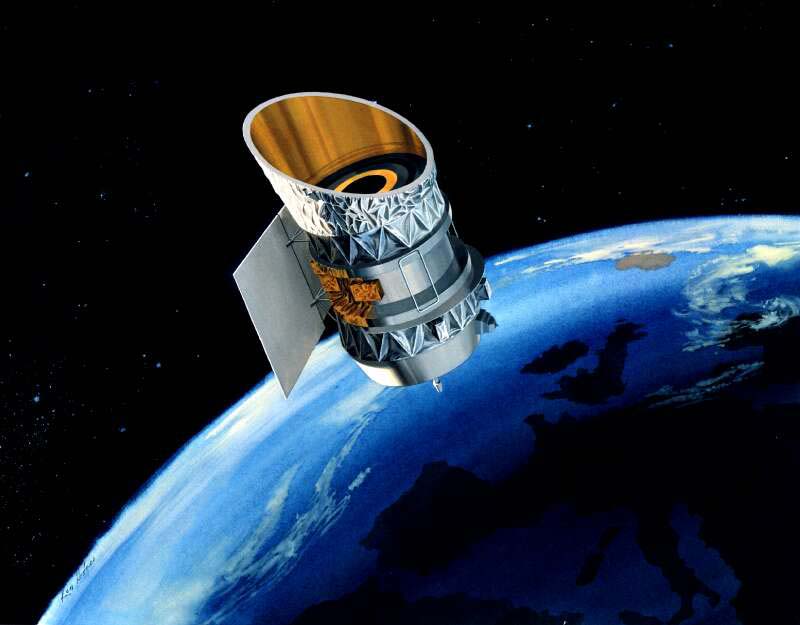Update. It looks like we didn’t roll a 1 on the d20, and the satellites passed each other without an impact. But this will probably become a more common occurrence as the skies get more crowded.
Over sixty years of space exploration have left their mark in Low Earth Orbit (LEO), where thousands of objects create the risk of collisions. These objects include the spent first stages of rockets, fragments of broken-up spacecraft, and satellites that are no longer operational. As Donald Kessler predicted, the growing presence of “space junk” could result in regular collisions, leading to a cascading effect (aka. Kessler Syndrome).
This evening – on Wednesday, Jan. 29th – such a collision might take place. These satellites are the Infrared Astronomical Satellite (IRAS), an old space telescope launched by NASA, the Netherlands, and the UK; and the GGSE-4 gravitational experiment launched by the US Air Force. These two satellites run the risk of colliding when their orbits cross paths at 06:40 p.m. EST (03:40 p.m. PST) about 900 km (560 mi) above Pittsburgh, Pennsylvania.
The task of tracking these satellites and keeping the public up to date on the likelihood of their collision is being carried out by LEOLabs, a that uses a worldwide network of orbital tracking arrays to provide mapping data and services. This data is made available to the public and private sector and allows for rapid orbit determination, early operational support, and assessment of collision risks.

As they indicated on Monday, Jan. 27th, on Twitter, LeoLabs calculated that the two objects will come within 15 to 30 meters (50 to 100 ft) of one another. As they wrote:
“On Jan 29 at 23:39:35 UTC, these two objects will pass close by one another at a relative velocity of 14.7 km/s (900km directly above Pittsburgh, PA). Our latest metrics on the event show a predicted miss distance of between 15-30 meters… These numbers are especially alarming considering the size of IRAS at 3.6m x 3.24m x 2.05m. The combined size of both objects increases the computed probability of a collision, which remains near 1 in 100.”
However, since then, LeoLabs has updated those odds to factor in some previously unforeseen factors. This includes the 18 m (59 ft) boom that was deployed by the GGSE-4 and the fact that they “do not know which direction it is facing relative to IRAS.” This altered their computations about a possible collision and “yields an updated collision probability closer to 1 in 20.”
To make matters worse, there is nothing that can be done to reduce the likelihood of a collision. Whereas the International Space Station (ISS) and operative spacecraft are able to adjust their orbits to avoid collisions, both the IRAS and the GGSE-4 have been inoperable for decades and can’t perform any corrective maneuvers.

Of the two satellites, the IRAS is the larger, measuring 3.6 x 3.24 x 2.05 meters (11.8 x 10.6 x 6.7 feet) and weighing 1,083 kg (2,388 lb) when it was launched. This was NASA’s first infrared space telescope and was responsible for a number of discoveries, which included six new comets, the core of the Milky Way, and protoplanetary disks around Vega and Fomalhaut.
Since both satellites are orbiting Earth at a velocity of 14.7 km/s (9.1 mps), this makes a collision a major risk for generating orbital debris that will spread into other orbits. According to calculations performed by The Aerospace Corporation, which also monitors and tracks orbital debris, a collision would generate 90,000 chunks of debris that are at least 1 cm (0.4 inches) in diameter.
This would place them on the cusp between the 900,000 objects tracked by the European Space Agency’s that measure between 1 cm and 10 cm and the 128 million objects that measure between 1 mm and 1 cm. While small, objects of this size pose a severe risk to the ISS, spacecraft, operational satellites, and space telescopes.
If there is a takeaway from this, it is just how important it is to track defunct satellites and assorted pieces of debris in orbit. As LeoLabs was sure to add:
“Events like this highlight the need for responsible, timely deorbiting of satellites for space sustainability moving forward. We will continue to monitor this event through the coming days and provide updates as available.”
As the orbital lanes become increasingly crowded due to the deployment of thousands of more telecom satellites, internet satellites, and CubeSats, mitigation strategies will also be needed. Many concepts are on the drawing board and several have already been validated in orbit. In the meantime, regular monitoring and vigilance are the best defense against collisions.
Further Reading: Business Insider


“Since both satellites are orbiting Earth at a velocity of 14.7 km/s” I think you mean their relative velocities to each other are 14.7 km/sec. Their intrinsic velocities in the Earth Centered Inertial reference frame would be roughly half that value. Escape velocity from low earth orbit is 11 km/s.